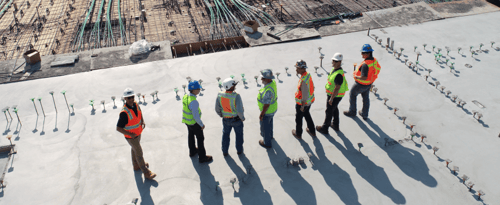
Work-related musculoskeletal disorders (WMSDs) account for 70% of reported occupational diseases and work stoppages. And these figures are increasing by 20% per year, which means that these disorders are becoming commonplace. Yet it is a public health problem, a major concern and a major economic issue for companies. Indeed, professional activity plays a major role in their appearance (static work, excessive efforts, stress, isolation, etc.). The entire population is affected, even the youngest. How then to identify work-related musculoskeletal disorders and prevent them? Here, we present some solutions.
WMSDs: what are we talking about exactly?
Definition
Work-related musculoskeletal disorders are conditions that affect the soft tissues around joints (muscles, nerves, tendons, ligaments, cartilage, blood vessels, etc.). They cause stabbing pain, discomfort during movement or stiffness in the affected area. The areas most at risk are the upper body, such as the back and shoulders, but also the elbows and wrists. When diagnosed too late, they can cause permanent damage, and not just in the elderly or those in poor physical condition. Even the youngest are affected!
Causes of musculoskeletal disorders
WMSDs can occur in many contexts, but work activity is the main cause. This is the reason why musculoskeletal disorders are recognized as occupational diseases in the General Health Insurance Plan. Here are the main factors behind musculoskeletal disorders in the workplace:
- Physical and mechanical factors: forceful movements, static postures, extreme and/or repetitive movements.
- Environmental factors: mechanical vibrations and shocks, noise volume and brightness, temperatures and climatic conditions.
- Psychosocial factors: stress caused by a harmful work atmosphere, tensions between employees, job insecurity, the pressure of responsibilities, job-related dissatisfaction, lack of recognition and support.
- Organizational factors: working time (fast pace, staggered hours, time off) and working conditions (lack of human or material resources, time pressure).
- Individual factors: aging of the body, decreased energy, decreased physical capacities, development of diseases, psychological fragility.
What are the consequences of musculoskeletal disorders?
For the health of employees and the group as a whole
Preventing WMSDs is a real challenge because it impacts the health and well-being of employees. Indeed, these disorders degrade the quality of life in the long term, with potential after-effects. They lead to professional disaffiliation and a decrease in productivity at work, coupled with a loss of autonomy. Chronic absenteeism related to WMSDs stoppages has repercussions on the team: heavier workloads, disorganization, deterioration of the social climate, high employee turnover, etc. To that effect, it is a vicious circle that, in itself, leads to new cases of work-related musculoskeletal disorders within a company.
For the economic health of a company
Work-related musculoskeletal disorders are costly: in 2017, nearly 2 billion euros in contributions were paid and 22 million workdays were lost due to stoppages related to WMSDs. As occupational diseases, WMSDs have an impact on the increase in the company's contribution rate, not to mention the expenses for replacing absent employees. For a company, it is estimated that the average direct gross cost of a work stoppage of more than 24 hours is 3,200 euros ($3,550). In addition to these short-term costs, the consequences of work-related musculoskeletal disorders are also negative in the long term: poor employer brand image, difficulties in recruiting, the need to adapt workstations, etc.
How do prevent musculoskeletal disorders?
Diagnose and analyze the risks and the situation within the company
Managers have a major role to play in occupational risk assessment (ORA) and work-related musculoskeletal disorders detection. They are in direct contact with their team, unlike HR. It is therefore up to managers to detect potential WMSD risks, identify the causes and prevent them. Managerial positions must be trained on this topic: everyone has a role to play in preserving the physical and mental health of employees.
Implement an effective prevention plan
The diagnosis of work-related musculoskeletal disorders risks must give rise to a prevention plan, both in the work environment and at home when teleworking. Tools as well as workspaces must be redesigned with better ergonomics in mind. Also consider the fact that there are 2 financial aids that contribute to a reduction of WMSDs:
- WMSD pros Diagnosis: to initiate and formalize a prevention project in the workplace.
- WMSD pros Action: to purchase material and/or equipment, but also to establish relaxation areas at the office to promote recovery.
Adopt a corporate culture of health and safety
To improve the working conditions of employees, do not hesitate to work with health professionals, but also try scheduling sessions during which employees may share and discuss their experiences. These meetings will allow you to share tips on how to avoid work-related musculoskeletal disorders and other sources of discomfort. The most important thing here is to communicate: show your employees that the company is looking out for them and involved in their well-being. Reassure them by sharing existing solutions and by encouraging them to speak out about their musculoskeletal disorders.
You can also organize a security day at work on the occasion of the Safety Day, the 28th of April. It’s a good opportunity to raise awareness among your employees on stakes such as health, well-being at work and develop a healthier corporate culture.
Conduct regular assessments
Once you have launched a preventive approach, it is essential to evaluate the results of your strategy to assess the impact and effectiveness of the measures taken to address the causes of WMSDs. You need to get yourself into a mindset of continuous improvement: listen to your employees and implement changes as you go along. Regardless of what you choose to do, employees are the cornerstone of your WMSD prevention efforts.
Offer a health program
Finally, to avoid physical inactivity, offer your employees a health program like United Heroes. Physical activity improves both physical and mental well-being. After one or more accidents at work, each individual can begin working again at their own pace, to find their place once again within the company and regain confidence in themselves and their skills!

Rédactrice web, ex Content manager @ Sport Heroes



